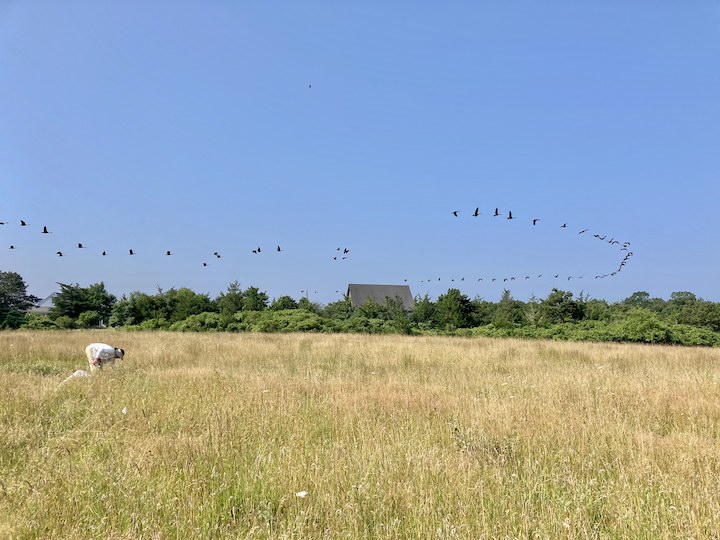My botanical skills have dulled.
I learned botany at the Yale School of the Environment, and began my training during one of the initial summer sessions called “mods.” I recall examining the grasses in a meadow at the base of Sleeping Giant—a basalt formation that indeed takes the shape of a giant lying upon his back—in Hamden, Connecticut, and learning the woody plants amid the hemlocks and northern red oaks that clothed the Giant’s body.
Looking back, I don’t recall the plants that I identified, but I do recall spotting a copperhead in a grove of hemlocks, and scrambling up the Quinnipiac Trail to the Giant’s head, and licking an ice cream cone at Wentworth’s on Whitney Avenue at the end of a long day in the field. Another botany day brought me to the shoreline in Guilford, Connecticut, where we found a prickly pear, the only cactus to grow in all 50 states, and yet another day brought us to a remarkable peat bog, deep in the rocky woods of north Madison.
My skills have since dulled not because of a lack of interest, and not because I rely on an app for plant identification. They have dulled because I am surrounded by expert botanists. When one works on a regular basis with such botanists as Kristen Geagan and Elizabeth Loucks at Sheriff’s Meadow Foundation and Julie Russell at the Land Bank, and such experts in the community as Margaret Curtin and Greg Palermo and Nancy Weaver, one quickly learns it is so much easier just to ask one of these experts, “what plant is this?” In a flash, the plant will have been identified, its Linnaean name recited, and a few points about the natural history of the species will have been shared.
When faced with a plant that I can’t identify, it is simply so much easier to ask the expert, than to break out the identification guide and key it out for myself. There is one exception however, to this dulling of skill. The exception is tree identification. For me, the knowledge of tree identification stretches back farther in time than the formal forestry training at Yale. I recall first learning to identify trees as a child, while walking in the woods with my grandfather. He helped me distinguish oak from maple and spruce from hemlock. The formal training expanded what my grandfather had taught me. I learned to examine bud scars and branching patterns. I noted the shapes of leaves: simple or compound? I examined the edges of the leaves: serrate or doubly serrate? I peered at the underside of the leaves – are they tomentose (slightly hairy)? Then, I began to identify trees in the winter, by the bark and by the buds. The northern red oak, for example, can be quickly identified by its interlacing “ski trail” pattern of striations up and down its stem. On mature sugar maples, the bark splits into great gray plates, and the branching pattern is opposite, not alternate. The elephantine stem of the American beech is unmistakable at any time of the year.
There are still trees I struggle with, especially trees with simple leaves, such as willows, or the different varieties of fruit trees, when not bearing fruit. Mostly, though, I find tree identification a sheer delight. Identifying trees makes any sidewalk stroll far more interesting. There is endless fascination in noting what others may have planted: the sweet gum growing in the sidewalk on Summer Street, beside the main office of the Martha’s Vineyard Bank in Edgartown, the tulip poplar at Sheriff’s Meadow Sanctuary, near Sheriff’s Lane, the American elms gracing the Village Green in Edgartown. And there is equally endless fascination in finding what planted itself on its own: the quaking aspens on the Quansoo Road, the witch hazels of West Tisbury, the paper birches of Squibnocket Pond Reservation.
Walking companions seem to enjoy learning about trees. It continues to amaze me how people love to learn about the beetlebung. They admire the tree, and the way it grows in dense stands in wet soils. Most of all, they marvel at the fact that the name “beetlebung” is peculiar to Martha’s Vineyard. Everywhere else, this common and widespread tree is known as the tupelo, or black gum, or Nyssa sylvatica. People enjoy knowing how to distinguish the different kinds of oaks that grow upon Martha’s Vineyard. They feel enlightened upon being able to discern the pitch pine from the white pine, and take joy in aging a white pine by simply counting the whorls of branches ascending up the stem.
As I have grown older, though, I find that identifying trees feels less like botany, and more like finding old friends. Happening upon trees invariably brings back memories. The tulip poplar beside the Brooks Trail? That reminds me of the tulip poplar that grew upon my grandparents’ lawn, at the top of a sledding hill. I recall the huge orange flowers that fell upon the grass, dripping nectar. The star-shaped leaves of the sweet gum by the bank? I recall the sweet gum that grew upon my neighbor’s lawn, and walking by that tree with my wife while pushing our children in a stroller. The ubiquitous eastern red cedar? I recall hiking with my father on the Mattabesett Trail on Connecticut’s Mt. Higby, seeing cedars clinging to the trap rock ledges. Fall nears, and for a few weeks of this season, the foliage of this island (especially where there are red maples and sumacs and beetlebung) and of New England shall leave awestruck all who witness this glory of nature. My skills may have dulled, but my enthusiasm has not. No matter one’s skill, there is no better time than fall to set out and identify trees.
Take an app, take a book, take a botanist, take a friend. Walk a trail, push a stroller, ride in a wheelchair. Study the leaves, identify the trees, and join me in finding our old friends.


